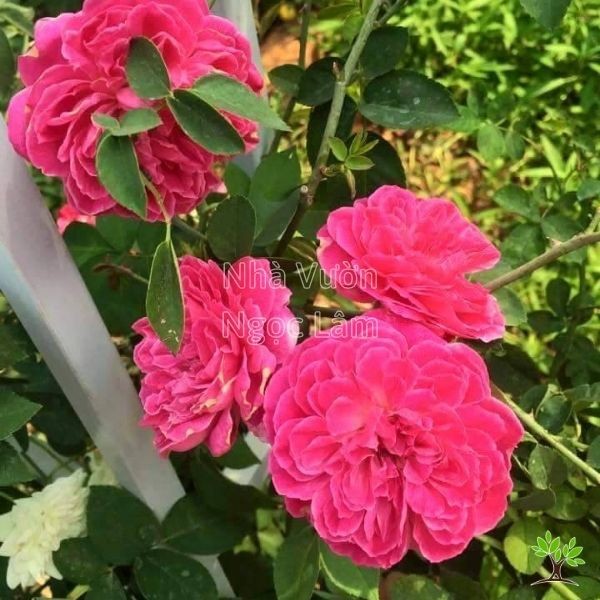No products in the cart.
NEWS
Unlocking the Charm of Tuong Vi Climbing Roses: A Comprehensive Growing Guide
Beloved by many, the Tuong Vi climbing rose captivates with its delicate beauty, enchanting fragrance, and prolific blooms. These enchanting roses, scientifically known as Rosa spp., are a popular choice for adorning walls, fences, and trellises, transforming ordinary spaces into breathtaking floral displays. If you’re wondering how to cultivate these lovely climbers, this guide from the experts at Biogarden.Asia will walk you through everything you need to know about growing and caring for Tuong Vi climbing roses.
Understanding the Tuong Vi Climbing Rose
Known also simply as Rosa ‘Tuong Vi’ or Wild Rose in some contexts, this plant is widely cultivated for its aesthetic appeal. Unlike some stiff rose varieties, ‘Tuong Vi’ possesses pliable stems often adorned with thorns, allowing them to easily cling and climb structures, potentially reaching heights of 2-3 meters or more when supported.
Key Characteristics
‘Tuong Vi’ roses typically bloom in clusters of 3 to 8 flowers, creating a cascade of soft color. A defining feature is their delicate pink hue (though white varieties exist, they are less common) and the multitude of thin petals. These petals overlap in a charming, layered fashion, forming full, beautiful blooms that release a gentle, pervasive fragrance. Similar to Bougainvillea, ‘Tuong Vi’ roses rely on support to climb effectively. Placing pots near walls or fences after they begin to flower is crucial for encouraging their natural climbing habit. This species is notably sun-loving and can thrive in a variety of conditions, though the warm climate often found in southern regions is particularly conducive to their vigorous growth.
Distinguishing from Similar Varieties
In Vietnam, the ‘Tuong Vi’ is sometimes confused with other members of the Rosa genus, such as the true Wild Rose (Rosa canina or similar local species, often called Tầm Xuân) and common Hybrid Tea or Floribunda roses. While all belong to the same family (Rosaceae) and genus (Rosa), they exhibit distinct morphological differences. You can differentiate them by observing a few key details:
- Tầm Xuân (Wild Rose): Characterized by wrinkled leaves that are whitish on the underside. Stems have small thorns and grow as deciduous shrubs with branches forming clusters. Flowers are often single or appear in small groups (2-3) at branch tips. Stems tend to be thicker.
- Tường Vi (Crape Myrtle): Note: This is a common confusion in Vietnamese. Tường Vi can refer to the climbing rose OR Crape Myrtle (Lagerstroemia). The original article clearly means the climbing rose here, but it’s important to clarify the potential confusion in English. Focusing on the rose ‘Tuong Vi’, its leaves are smoother (not wrinkled) and lack the long, soft hairs found on some Rosa species. The climbing habit is pronounced, and flowers are multi-petaled, often in conical or dense shapes.
- Hybrid Tea / Modern Roses: Typically lower growing (bushes), with glossier leaves. Flowers often bloom singly or in smaller clusters (1-3), though some varieties cluster. They bloom repeatedly (“four seasons”). The key difference with ‘Tuong Vi’ is the climbing habit and the specific form and profusion of the clustered blooms.
Optimal Conditions for Growth
Understanding the preferred environment is key to successfully growing ‘Tuong Vi’ climbing roses and encouraging abundant flowering.
 Climbing Tuong Vi Rose in a Pot
Climbing Tuong Vi Rose in a Pot
Climate Preferences
While ‘Tuong Vi’ roses are known for their drought tolerance, planting during the peak heat of summer is not ideal. The best times to plant are during the cooler periods of autumn or early spring. These roses flourish in warm, humid climates and prefer temperatures between 15°C and 25°C (59°F – 77°F). They require ample sunlight to produce the most blooms.
Soil Requirements
‘Tuong Vi’ roses possess robust root systems that allow them to survive even in less-than-ideal conditions, including temporary waterlogging or dry spells. They can also tolerate nutrient-poor soil or locations with limited sunlight. However, for continuous flowering throughout the year and to produce large, vibrantly colored blossoms, regular nutrient supplementation is highly recommended. Well-draining soil is crucial to prevent root issues, but their strong roots offer a degree of resilience.
Step-by-Step Planting Guide
Choosing the right location and following proper planting techniques will give your ‘Tuong Vi’ rose the best start.
Best Time to Plant
As mentioned, autumn or early spring are the most favorable seasons for planting ‘Tuong Vi’ climbing roses. Planting during these times minimizes stress from extreme heat, allowing the plant to establish its roots before facing harsh weather. Avoid planting in the heat of summer, which can easily lead to wilting or death.
Planting in the Ground
Select a spot that receives direct sunlight for several hours a day. The soil should be well-draining and not prone to waterlogging. Avoid areas that are heavily shaded or constantly wet. Dig a hole that is twice the size of the root ball in both depth and width. Before placing the plant, amend the bottom of the hole with organic fertilizer or microbial soil amendments. The amount will depend on the size of the plant you are transplanting. Gently place the root ball in the hole, backfill with soil, and water thoroughly.
Planting in Pots
When growing in containers, choose a pot large enough to accommodate the root system’s growth and ensure it has excellent drainage holes. Place the pots in locations that receive ample sunlight, such as windowsills, balconies, or patios. Avoid shady spots, as insufficient light will hinder growth and flowering. It’s essential to design a good drainage system within the pot (e.g., a layer of gravel or pottery shards at the bottom, though mixing perlite into the soil is often more effective). To protect the plant from wind and external factors, providing a sturdy stake or support structure immediately after planting is beneficial.
Caring for Your ‘Tuong Vi’ Rose
Caring for ‘Tuong Vi’ roses doesn’t have to be difficult. With consistent attention to their basic needs, these resilient climbers will reward you with stunning blooms.
 Caring for Tuong Vi Climbing Roses
Caring for Tuong Vi Climbing Roses
Watering Needs
While not overly demanding, ‘Tuong Vi’ roses prefer consistent moisture and should not be allowed to dry out completely for extended periods. The amount of water needed varies depending on the plant’s growth stage and the weather.
- During cool or rainy weather, less frequent watering is needed.
- In hot, sunny conditions, the demand for water increases significantly.
- On long sunny days, daily watering may be necessary, especially for potted plants.
Young plants establishing their roots require less water than mature plants, particularly those that are flowering or have a large canopy, as they consume water much more quickly. Water the base of the plant to avoid wetting foliage, which can encourage fungal diseases.
Light Requirements
As previously noted, ‘Tuong Vi’ climbing roses are sun-lovers. They need plenty of bright light to thrive and produce abundant flowers. When growing in pots, position them in sunny locations like balconies or near windows to maximize natural light exposure. They can tolerate some shade but will flower less profusely.
Pruning Techniques
Regular pruning is essential for maintaining the shape, health, and flowering of your ‘Tuong Vi’ rose. Prune canes moderately, focusing on removing weak or crowded shoots. This directs the plant’s energy towards developing stronger growth and more blooms. After the main flush of flowers fades, prune the spent canes back to a point with 2 to 4 leaves below the old flower cluster. This encourages the plant to produce new growth and rebloom. The plant typically begins setting hips (rose fruit) from September to December after flowering has finished.
Pest and Disease Management
Like many roses, ‘Tuong Vi’ climbers can be susceptible to common issues such as fungal diseases like powdery mildew, black spot, and rust. If your rose shows signs of these problems, integrated pest management strategies are key. This includes ensuring good air circulation, avoiding overhead watering, and promptly removing affected leaves. For treatment, consider using biological control agents or appropriate organic fungicides. If chemical intervention is necessary, choose a broad-spectrum fungicide suitable for roses and follow application instructions carefully.
Common diseases to watch for include:
- Powdery Mildew: Appears as white, powdery patches on young leaves, stems, and flower buds. It can distort leaves, stunt growth, and prevent flowers from opening. Ensure good air circulation and sunlight penetration.
- Black Spot: Recognized by distinct black spots, often with fringed edges, on the leaves. These spots cause the leaves to yellow and drop prematurely, weakening the plant. Remove infected leaves and debris.
- Rust: Manifests as small, raised, rusty-orange pustules, usually on the undersides of leaves. Severe infestations can cause leaf yellowing, wilting, and premature drop.
Early detection and treatment are crucial for managing these issues effectively.
Frequently Asked Questions (FAQs)
Here are answers to some common questions about growing and enjoying ‘Tuong Vi’ climbing roses.
How to Encourage Year-Round Blooms?
To promote continuous flowering, especially after a large flush, prune back the canes that have finished blooming. Cut the spent stems back, leaving 2 to 4 leaves below where the flowers were. Remove excess foliage to encourage new shoots. Apply a dose of fertilizer suitable for flowering plants and continue regular watering and care. With this technique, the plant can produce new blooms within a week, allowing you to enjoy flowers throughout the season or even year-round in suitable climates.
How to Arrange ‘Tuong Vi’ Roses in a Tall Vase?
While this guide focuses on growing, enjoying the cut flowers is part of the pleasure! Arranging these beautiful blooms in a tall vase requires a bit of care and technique.
- Start with a clean vase. Wash it thoroughly with soap and water, then dry it.
- Use lukewarm water (35-40°C or 95-104°F) rather than cold water. You can add a small amount of flower food, bleach, mouthwash, or lemon juice to the water to help keep the flowers fresh longer.
- Before placing stems in the vase, remove any soil, dust, and leaves that would fall below the waterline. Leaves in the water can cause bacterial growth, shortening the vase life.
- Using a sharp knife or pruning shears, cut the stem ends at a 45-degree angle. This increases the surface area for water uptake.
- To create shape, cut stems to various lengths. Place the longest stems in the center of the vase.
- Arrange shorter stems around the center to create a rounded or desired shape for your arrangement.
- Use filler flowers or greenery to complement the roses and add visual interest.
Start Your Biogarden Journey with ‘Tuong Vi’ Roses
You’ve now learned some fascinating details about the enchanting ‘Tuong Vi’ climbing rose, from its characteristics and ideal growing conditions to essential care tips and tricks for continuous blooms. You even have tips for enjoying their beauty indoors! If you dream of a garden gate covered in breathtaking rose blossoms, or a balcony overflowing with fragrance, the ‘Tuong Vi’ rose is a wonderful choice. Growing these beautiful climbers is a rewarding experience.
At Biogarden.asia, we can support your gardening endeavors with quality soil amendments, fertilizers, and plant care products designed to help your ‘Tuong Vi’ roses thrive. Explore our range of products and discover more expert advice to make your gardening dreams a reality. Get in touch with us or visit our website to find everything you need to cultivate a stunning rose display!



